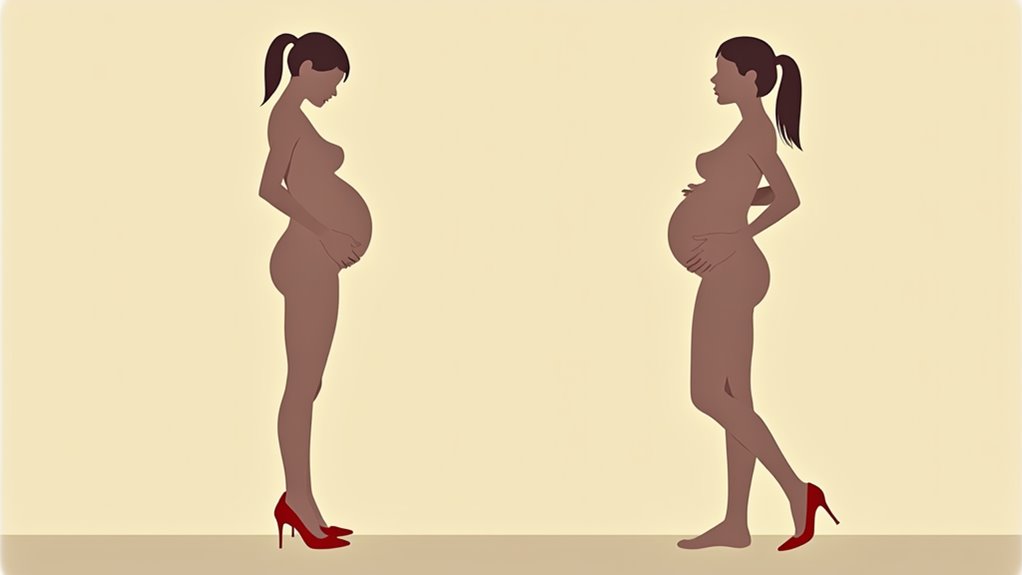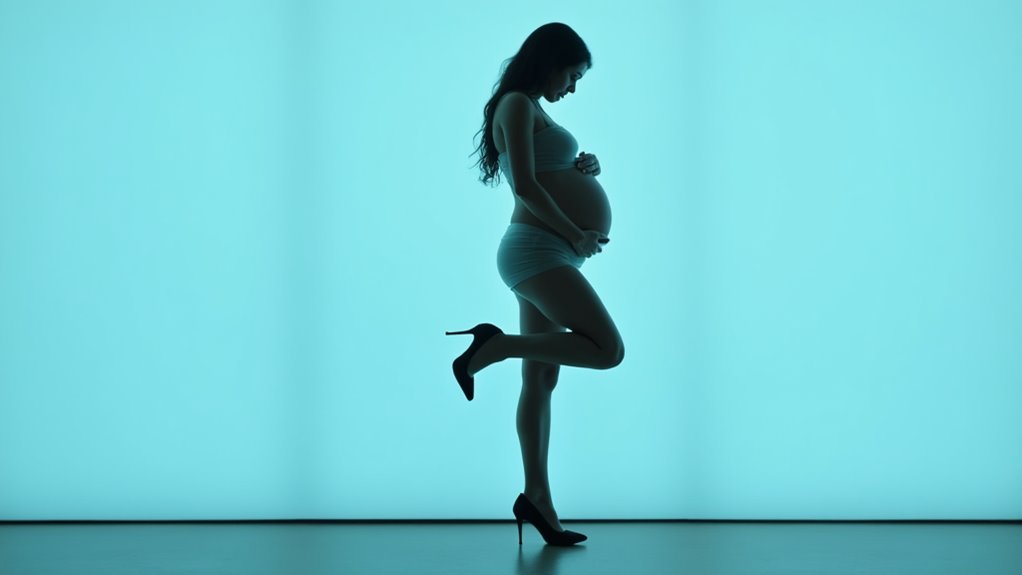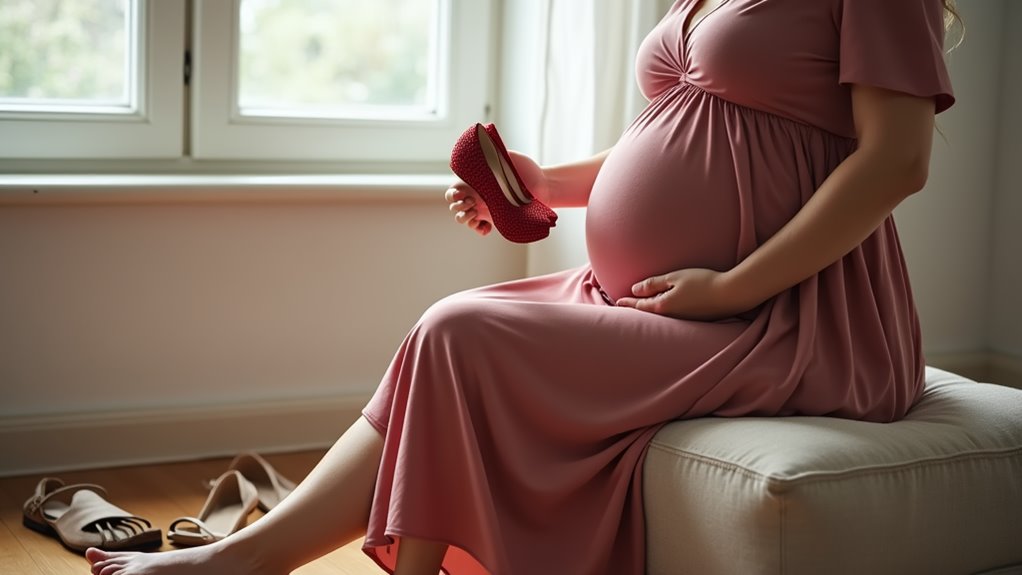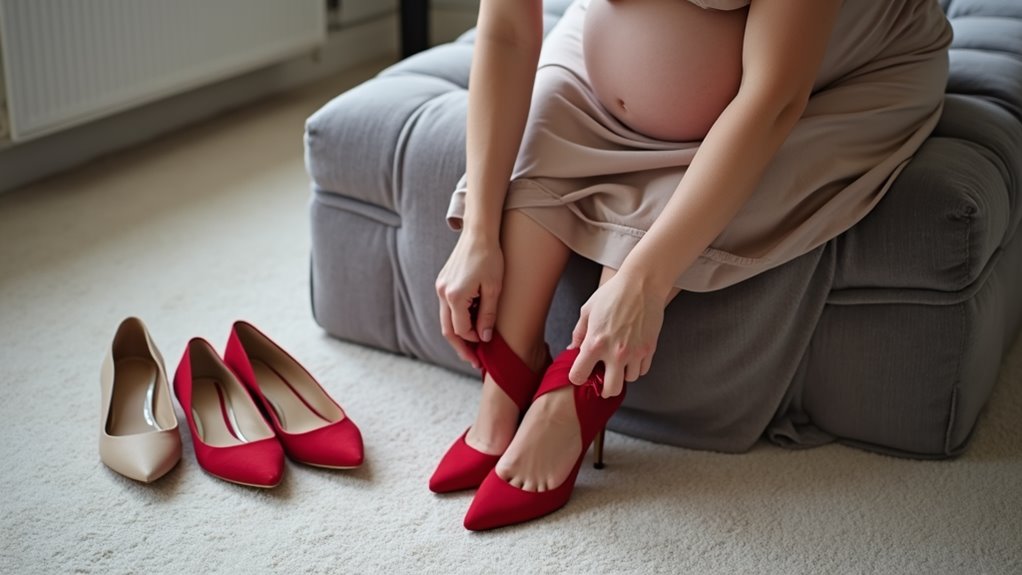There may be products. Products are independently selected by our editors. We may earn an affiliate commission from the links with no charge to you, example: as Amazon Affiliate.
While pregnancy hormones can stretch your ligaments up to 10 times their normal length, you’re likely unaware that this biological change dramatically affects how your feet respond to different types of shoes. If you’ve been wondering whether you can keep wearing your favorite heels during pregnancy, you’ll need to consider more than just comfort. The combination of loosened ligaments, a shifting center of gravity, and increased body weight creates unique risks that could impact both you and your baby’s safety. Let’s explore what medical experts want you to know about high heels during pregnancy.
Key Takeaways
- Wearing high heels during pregnancy increases fall risk due to hormonal changes affecting balance and shifting center of gravity.
- Physical changes during pregnancy cause ligament loosening and swelling, making high heels particularly uncomfortable and potentially harmful.
- Regular high heel use can worsen back pain, strain pelvic muscles, and increase the likelihood of developing varicose veins.
- Supportive footwear alternatives like cushioned flats or athletic shoes provide better stability and comfort during pregnancy.
- Custom orthotics and compression stockings can help manage foot discomfort while maintaining style with appropriate pregnancy-friendly shoes.
Understanding the Physical Impact

While pregnancy brings natural physical changes to your body, wearing high heels can significantly amplify these effects.
During pregnancy, your ligaments naturally loosen due to hormonal changes, making it harder for your feet to maintain stability in heels. You’ll also experience increased swelling in your feet, which high heels can worsen by restricting blood flow.
Your body’s center of gravity shifts forward as your pregnancy progresses, and high heels can further disrupt this delicate balance.
The added weight of pregnancy combined with heels puts extra strain on your joints, particularly your knees and pelvis. You’ll likely notice more pressure on your lower back since heels alter your posture, forcing your spine to compensate for the unnatural position.
Hidden Dangers of High Heels
Although high heels may complete your favorite outfit, they pose serious risks during pregnancy that extend far beyond simple discomfort. When you’re expecting, hormonal changes and weight gain already affect your balance, making falls more likely. Wearing high heels significantly increases this risk, potentially leading to serious injuries or miscarriage.
Your body faces additional hidden dangers when wearing heels during pregnancy:
- Increased strain on your back and pelvis, causing severe pain and sciatica.
- Higher risk of developing varicose veins and swollen feet.
- Greater chance of muscle cramps and foot deformities.
- Potential long-term damage to your feet, including permanent changes in shape and size.
You’ll also find walking on uneven surfaces more challenging, as your center of gravity shifts throughout pregnancy. The risk of falls becomes comparable to that of women over 65.
Balance and Posture Changes

During pregnancy, your body undergoes significant postural changes that make wearing high heels particularly dangerous. Your center of gravity shifts forward as your baby grows, while pregnancy hormones reduce your ankle strength, making balance more challenging.
When you add high heels to this equation, you’re creating an even more unstable situation. High heels force your pelvis into an anterior tilt and increase lumbar lordosis, putting extra strain on your back and pelvis. You’ll need to work harder to maintain your balance, as the heels alter your foot mechanics and walking gait.
These changes, combined with pregnancy-related muscle stretching and fatigue, significantly increase your risk of falling. Your body’s natural compensatory mechanisms at the hip and knee joints become compromised, making it harder to maintain stable posture.
Safe Footwear Alternatives
Since comfort and safety are paramount during pregnancy, choosing the right footwear becomes essential for your daily activities. You’ll find several comfortable alternatives to high heels that provide the support and stability you need.
For everyday wear, consider these top pregnancy-friendly shoe options:
- Ballet flats with cushioned insoles and arch support, like Rothy’s The Flat or Madewell’s Greta
- Slip-on sneakers from brands like Kizik or Orthofeet that feature hands-free designs
- Supportive athletic sneakers such as Brooks Adrenaline or Hoka Cliftons
- Indoor recovery shoes like Oofos or Hoka sandals for at-home comfort
You don’t have to sacrifice style for comfort – many of these options come in fashionable designs while providing the essential support your feet need during pregnancy. Consider exploring natural material shoes that provide both eco-friendly benefits and breathable comfort during your pregnancy journey.
Making Smart Shoe Choices

Making informed decisions about your footwear can protect both you and your baby throughout pregnancy.
If you must wear heels, choose ones that are no higher than one inch with a sturdy, wide base. You’ll want to avoid thin stilettos, which can make balancing particularly challenging.
Look for shoes with proper arch support and cushioning at the ball of your foot.
For maximum comfort, consider investing in formal comfort heels designed specifically with cushioning and support features.
If you’re attending special events where you’ll wear heels, bring a comfortable backup pair and take regular breaks to remove your shoes.
As your pregnancy progresses, especially in the third trimester, you’ll need to be extra cautious about your footwear choices.
Don’t hesitate to consult your healthcare provider for personalized recommendations based on your specific needs and stage of pregnancy.
Comfort Solutions for Expecting Mothers
As your body changes throughout pregnancy, finding comfortable footwear becomes essential for your daily well-being.
Custom orthotics offer a versatile solution that you can use across different shoes while providing crucial support for your changing needs.
To maximize your comfort during pregnancy, focus on these key footwear features:
- Choose shoes with supportive arches and cushioning at the ball and heel
- Opt for adjustable sandals or shoes that accommodate foot swelling
- Select sturdy, non-slip soles to prevent accidents
- Consider low-heeled options instead of completely flat shoes
Custom orthotics can complement your footwear choices by providing targeted support throughout your pregnancy stages and even after delivery.
They’ll help alleviate pain, maintain proper alignment, and prevent serious foot issues while supporting your body’s changing needs.
Finding the right medical footwear solutions can significantly improve your comfort and mobility during pregnancy.
Managing Foot Health During Pregnancy

While pregnancy brings many physical changes, proper foot care becomes crucial for preventing discomfort and maintaining mobility during these nine months.
You’ll want to prioritize wearing supportive shoes that fit well and offer good arch support. Consider adding custom-fitted orthotics to help distribute your weight evenly and reduce strain on your feet.
To manage swelling, elevate your feet whenever possible and wear compression stockings. You can also reduce edema by staying hydrated, lowering your salt intake, and getting regular gentle exercise.
It’s best to avoid walking barefoot and limit high heel use, as they can worsen balance issues and increase your risk of falls.
Regular foot massages and warm baths can help relieve pain and improve circulation throughout your pregnancy.
If you must wear heels, opt for comfort-focused heels that provide better stability and support for your changing body.
Preventing Pregnancy-Related Foot Problems
To prevent foot problems during pregnancy, you’ll need a comprehensive approach that combines proper footwear, regular exercise, and good foot care habits. Start by choosing wide, comfortable shoes with proper support, and consider using custom orthotics if you experience pain or discomfort.
Here’s what you can do to protect your feet during pregnancy:
- Replace your high heels with supportive low-heeled shoes to maintain balance.
- Wear compression socks to improve circulation and reduce swelling.
- Exercise regularly with low-impact activities like walking or swimming.
- Elevate your feet above heart level whenever possible.
Don’t forget to visit a podiatrist for regular check-ups, and avoid walking barefoot, even at home. Instead, wear supportive slippers or sandals to protect your feet and maintain proper alignment.
Conclusion
Let’s face it – you’re not strutting down a runway, you’re waddling down the grocery aisle. While you might think those stilettos make you look fierce, they’re really just making you look like a penguin on stilts. Do yourself (and your future self) a favor – trade those sky-high heels for something sensible. Your swollen feet, aching back, and unborn child will thank you later.
